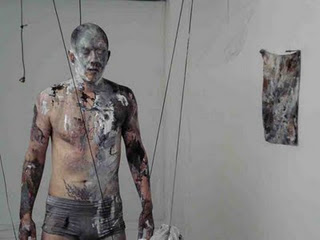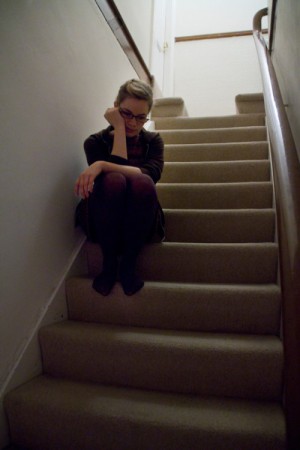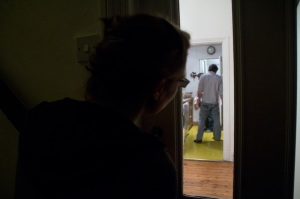This section contains reviews and critical writing related to events at 25sg. Please scroll down.
Content:
Katrin Auld at 25 Stratford Grove – Iris Priest
Piss and Sick: Thoughts on Kris Canavan’s Version 1 – Nick Kilby
ROOMS IN FLUX – Denise Kwan
Katrin Auld at 25 Stratford Grove
text: Iris Priest
I am sat in a warm and familiar room of 25 Stratford Grove, both a terraced house, a home and an artist run space, located in a leafy corner of Newcastle. The house, for anyone who doesn’t know it, is a hub for the generation of fresh ideas, experimentation and new work with an emphasis on supporting innovative approaches and alternative perspectives, particularly through participation, collaboration and live art events.
During the winter of 2010/ 2011 25 Stratford Grove underwent a significant renovation and changes to its layout. Since then, Katrin Auld had deliberately chosen to exclude herself from the programme of events and happenings, instead holding back for the opportunity to explore this new space through her senses other than sight i.e. holistically developing an image of the space through touch, smell, hearing, taste and any other senses.
We are here, myself and four other artists/friends, because each of us received a personal invitation to participate in what Katrin described in her email as “…not a performance but rather a ‘drawing’/exploration…”. Gathered in the recently refurbished main downstairs room, our gentle chatter subsides as we hear the latch of the back gate open and Katrin, her left elbow supported by Carole Luby, steps a little shakily into the front yard.
Her eyes are closed.
We watch through a large bay window as they make their way to the back door of the house. Katrin touches the plants with the hesitance and delicacy of a young child, stopping to smell for flowers. Her feet slide along the floor, tentatively groping for steps and solid foot holds. Upon entering the house she carefully feels her way along the walls and worktops – talking as she goes; comparing how it feels now to what she remembers of the space – gradually making her way down into the room where we are all sitting. As Katrin kneels on the floor, I feel slightly uneasy somehow, as if I’m a voyeur on an intensely personal moment. Carole follows her closely, watching her progress with an almost maternal care, every now and again putting her hand on Katrins shoulder for reassurance. As she feels her way along the floor Katrin describes to us the patina of the smooth, new wood and compares it to her memory of the floorboards in the old room. She exclaims at the sudden, evocative smell of baking bread and, as she nears the hot face of the oven, I feel the first (but not the last) collective drawing-in-of-breath.
Later that evening, when we gathered in the unchanged living room of 25 Stratford Grove, Katrin (with her eyes open) began to explore that relationship between the remembered (visual) space of the past and the felt (sensory) space of the present. She described her experience of the perceived vastness of the new space :
“It was really eerie that it was never ending…”
In the context of this cosy and familiar domestic setting her description evoked (for me) an unsettling sensation; that of standing on the precipice of a great, unfamiliar darkness; of the formlessness of a universe no longer experienced through visual perception and a single perspective (the projective geometry of perspective beginning with ourselves and seemingly beaming outwards into the world). Katrin went on to describe how it had been her intention to explore the space through those alternative means of sense; as a sort of site-responsive drawing in the dark and compared this approach to the way in which Pina Bausch had danced her part in Café Müller blindfold “…to really explore how her body reacted to the space and her movements.” But whereas Pina Bausch’s dance had been a visceral, expressive externalisation of inner worlds, Katin Auld’s piece had been a quiet, intimate exploration of a space, primarily experienced by her internally.
Whilst our main point of access to the work began with the commentary accompanying Katrin’s experience (the space and her mental image of it as ciphered through her physical experience of it) this continued to extend and evolve through our conversation afterwards. The discussion did not follow a single line of enquiry but rather, reflecting the scope of individuals at the event, embarked through many different perspectives and avenues of discussion. The work, and the discourse proceeding it, reminded me of the Jainist concept of Anekāntavāda as illustrated by the fable of ‘The blind men and the elephant’. Anekāntavāda, which translates as “non-absoluteism”, proposes the idea that reality is multifaceted and beyond the comprehension of any single perspective or experience of it (and, as such, encourages practitioners to engage with alternative perspectives, ideologies and backgrounds). In the fable six blind men meet an elephant but each man, touching a different part of the elephant (his leg, his side, his tail, his tusk etc), form a different image of what they believe the elephant to be like. When they disagree a sighted man tells them that they are all right in part but that the entirety of the elephant can only be imagined by putting all of these perspectives together. Similarly, as we sit in a circle in Carole’s front room, we are talking about different aspects of an elephant we cannot wholly see or understand but instead work collaboratively to trace a map of it according to our various perspectives and ideas. These aspects of the elephant vary from the ‘tabboo’ of touch and confabulation of memory (Jane); the “ hunt for reassurance” and exploration of the familiar and the unfamiliar through alternative senses (Andrew); the gap or slippage between reality and perceptions of the world when experienced through senses other than sight (Rachael); the metaphorical possibilities and interpretations of ‘blindness’ and the way one must adapt to loosing their “most loved senses” (Carole); or the prioritising of senses (particularly sight) and incomplete or misinformed realities this constructs (Iris).
The event itself which Katrin had originally proposed as an “exploration” or a sort of site-responsive “drawing” invited a kind of paradox in terms of writing about it… Writing, and the finite words with which we use to describe a thing, being themselves rooted in the tangible and finite syntax of signs and images. What her drawing invited us to explore (both those in attendance and people experiencing it afterwards) was another construction of reality; an interrogation of our own ways of perceiving to search for alternative means and possibilities; to grope to understand the world through the experiences of another. In short, what this work created was not a singular finished performance or event but a key to accessing the world through a multiplicity of perspectives and approaches.
Originally posted: http://schediosunrehearsed.blogspot.com/2011/10/katrin-auld-at-25-stratford-grove.html
Piss and Sick: Thoughts on Kris Canavan’s Version 1
Text: Nick Kilby
Photos: Rachael Allen
I have for some time been involved in a dialogue both personal and artistic (if you would class the two as seperate) with Nicola and Kris Canavan and whilst I have spent many hours discussing their work and viewing documentation I had yet to see them action. Having unfortunately missed their joint collaboration of their week long residency at 25 Stratford Grove I did witness Kris’ action of Version 1, taking place in the converted garage space.
The piece unfolds from the image of a static body, bound to the space by a pulley system of cotton upon which is connected large blocks of frozen urine, collected in the run up to the event. The audience is invited to witness the piece either within the space, or in a more voyeuristic and detached manner through a large window from the yard outside. Canavan signals the beginning of the piece with a bleeding from the head, and then the body begins to move.
To say that Kris falls through the piece would be a gross underestimation of the time that he has spent working through the piece psychologically. There does however appear to be an element of discovery within the piece that can be seen and is captivating to watch; in much the same way that you would stand fascinated as a statician calculates odds in some indecipherable language and the way they move through these equations with a focussed, investigative mind.
The tension of standing watching the piece with no more than 10 people has to be taken into account. We all know Kris personally but this makes the piece no more important than viewing a stranger actioning at a platform or club event. There is no ego to prove something, nor external preconceptions about the artist that can be prevalent within the context of a multi line up setting. What we are witnessing is a raw, primal message being enacted upon the body.
Version 1 is unapologetically old school in its invocations of previously utilised aesthetics. There are clear nods to the works of Gunter Brus with the body being enveloped in paint and being grotesqued by the piece’s mechanics; the cherubic face is twisted and warped by the wrapping of string cotton around his face and frame. The body is being mashed and traumatised by the voluntary yet robotic turning on its own static axis. This turning raises blocks of frozen piss which melt and break apart, giving some relief to the tension on the body as the load is lightened. There comes an ecstatic breakout where Canavan unhitches himself from the machine and smashes the now cracked blocks with a hammer, scattering shards of yellow ice throughout the space and reaching into the boundaries of the room.
The piece has to be seen within the social context of the area and the period in which this piece has been crafted. Jarrow is where Canavan resides and the weight of the historic march to London that took place hangs off the piece and could be viewed as a springboard into unlocking the mystery of the action. This is essentially a social conflict abstractly presented upon the body, with the dripping of black and white paint upon head and torso producing shades of grey.
Whilst the subject matter is heavy the piece is not a difficult one to watch, it is injected with a sense of cheeky rebellion throughout. The word ‘SICK’ carved into Canavan’s chest which is clearly a nod to brandings given in the mainstream media and art press about both body work and the the recent rioting throughout England just weeks earlier. It could be read that the choice of font (a kind of scarification graffiti wild-style) is a direct tribute to the urban youth which were so readily dismissed by the right wing press as thugs and vandals that participated in the political action. We also see a beautiful moment in which he places a tin bowl upon his head and a mischievous affectation as the paint drips down, in much the same way a child would dispose of an unwanted meal.
Kris Canavan is an artist with a mixed legacy; the process of the solo work beneath the aesthetic standing in sharp contrast to his recent investigations with his wife Nicola and performance to camera with Dominic Johnson. This collaborative work can ultimately be seen as poetic affirmation of the ying and yang love brings and investigation of powerplay within relationships. His solo work seems to tread the boards of political dissent and a frustrated need to problem solve his own agitated and enquiring mind of sex and society. Version 1 like much of his work is a beautiful, playful, FUCK YOU.
For further information and documentation of the work and Kris Canavan please visit:
http://www.kriscanavan.com/index.html
Originally posted: http://notesoncruelty.blogspot.com/2011/09/piss-and-sick-thoughts-on-kris-canavans.html
ROOMS IN FLUX
Text: Denise Kwan
Why do we always have to go to the theater to see what is happening and not to see what is happening to us?
Federico Garcia Lorca, Comedia sin título, 1936
Amongst a row of Victorian houses is 25 Stratford Grove, inside is a two-hour durational performance, Rooms In Flux by the Improv Group. This is not a conventional gallery space or a white cube or a warehouse. 25 Stratford Grove is a house: A lived-in home. It has all the tell-tales signs; stacked books, herbs and plant collections and the smell of cooking.
The visitor is welcome to explore the house. At the bottom of the leafy garden sits a girl tapping mysteriously at a typewriter, a woman sits behind the large bay windows staring vacantly into the garden, the television behind her is stuck on a frozen image while a boy upstairs sleeps restlessly. Downstairs the towels, the sheets and dishcloths are being folded, crumpled, folded and crumpled again. A disquieting atmosphere murmurs throughout the house. Rarely do two people occupy the same space: As one enters, the other vacates. They live in isolation together.
Oblivious to your presence, these characters exist in a world of their own. Standing at the bottom of the stairs, a girl hammers down; breathless she suspiciously peers into the next room and her face is inches away from mine. They gather in the dining room and erupt into conversation. Resembling a family unit, they make preparations for a
party. They adopt archetypal characters; the mother is organised but anxious while her three children debate between essential party foods. Unexpectedly the light switches off and party music turns on. Suddenly they acknowledge your presence, like you were there all along; their faces light up, offering a drink and a handshake like old friends. Shortly the music dies and they fade back into their world.
Rooms In Flux is not strictly a performance or real life; rather it sits between these thresholds. The routine of repetitive chores and trivial conversations are strangely addictive, and the banality of daily living is mesmerizing and voyeuristic. Rooms in Flux absorbs the psychology of domesticity to its full capacity.
The ethos of Rooms In Flux chimes a similar sentiment to French Surrealistic playwright Antonin Artaud’s thoughts on theatre and daily life. He believed theatre and life had become vacuous and needed to reconnect with instinct and truth. In this scenario there is no stage and there is no line to separate the performance of drama and the drama of daily life. Inseparable they remain. An experience both alien and familiar to these domestic scenarios, we are newly exposed to the banal routines and suffocating tensions of domestic living. By connecting the theatrical and the domestic familiar our domestic environments suddenly become all the more complex and unfamilar.
What is the difference between the daily scripts we follow to cue within four walls, and the heavily rehearsed melodramas played out on a stage?
Published originally:
http://linemagazine.tumblr.com/post/3854096516/rooms-in-flux-why-do-we-always-have-to-go-to






